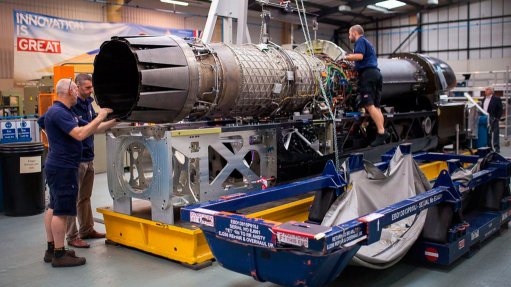
Fitment of the jet engine into the Bloodhound body
Photo by: Stefan Marjoram
The Bloodhound build team said it had achieved “a significant milestone” in the construction of the land speed record attempt vehicle, when it fitted the EJ200 jet engine to the body of the car on October 1.
Normally found powering a Eurofighter Typhoon, the EJ200 jet engine weighs one ton, and produces 90 kN, or 9 t, of thrust.
A team of five technicians spent eight hours ensuring the jet engine was a perfect fit with the upper and lower chassis, as well as the carbon composite air intake on the Bloodhound vehicle.
In a jet fighter, the EJ200 is designed to hang from a single mounting point, with the Bloodhound replicating this.
The upper chassis is made of strong, but light aluminium, to which titanium stringers and titanium skin will be fixed using glue and 1 400 aircraft specification rivets.
The lower chassis below the jet is made of aluminium and steel and houses the NAMMO hybrid rocket.
The two power plants together produce the equivalent of 135 000 thrust horsepower, or the output of 180 Formula 1 cars.
The Bloodhound has three power plants: the Rolls-Royce EJ200 jet, a cluster of NAMMO hybrid rockets, and a 650 bhp petrol racing engine used to drive the rocket oxidiser pump.
The build team had also trial-fitted the upper chassis ribs over the jet engine, to check the fit and clearance for the numerous fuel, electrical and hydraulic systems, before the upper chassis is assembled, bonded and riveted.
The workshop is a hive of activity as more than 3 000 components are delivered from manufacturers all over the world.
The vehicle is being assembled at the Bloodhound Technical Centre, in Avonmouth, Bristol, in the UK.
“This is a fantastic moment in the project. It’s great to see the jet engine fitted. It validates the many years of hard work by our team of motor sport and aerospace engineers,” said Bloodhound chief engineer Mark Chapman.
The build project is on course for the finished car to begin low-speed testing (up to 321 km/h) at Newquay’s Aerohub, in 2015.
Bloodhound will then fly to South Africa’s Hakskeen Pan for the start of the land speed record campaign, later that year, with the goal to reach a speed of 1 609 km/h in 2016.
The current world land speed record of 1 228 km/h is held by the Thrust supersonic car, a UK team led by Bloodhound project director Richard Noble and driver Andy Green.